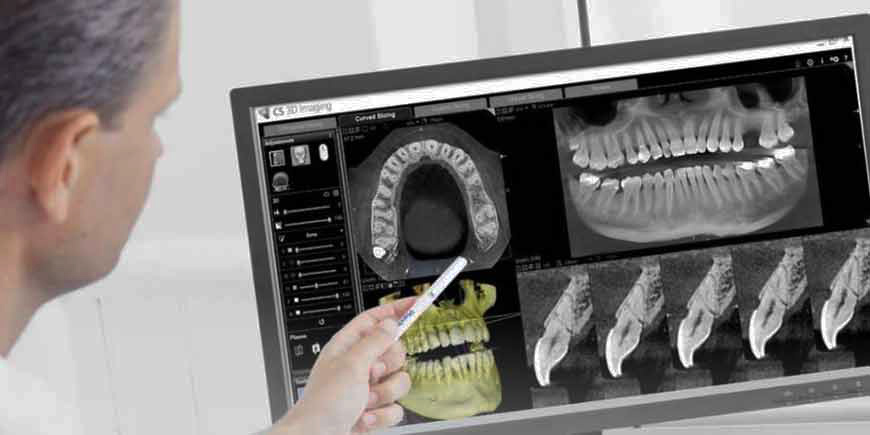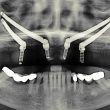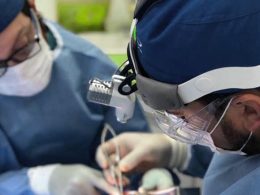Table of Contents
Implant Dentistry has a particular need to assess the three-dimensional structure of the jaw bones. Traditionally two-dimensional radiographs have sufficed for most Dentists’ needs such as with restorative or endodontics. While the advent of Cone-Beam Computerized Tomography (CBCT) has improved our diagnostic capability in many cases, two-dimensional radiographs still dominate as the radiograph of choice for most professionals.
Implant Dentistry is where this standard shifts. The essence of all dental implant placement surgery involves three-dimensional unfolding in an inconspicuous space. Two-dimensional radiographs can provide important information, but they often lack the spatial detail necessary to achieve the maximum precision, essential in this type of procedure.
Its Benefits
They can range from achieving better treatment results to reducing surgical risk.
Complications in oral implantology are relatively frequent and can range from mild to severe. One of the most frequent errors is the placement of the implant in a bad position. This can result in a series of later complications: fenestrations, dehiscences and recessions, restorative difficulty, poor biomechanics, loss of interproximal structure and damage to the adjacent anatomy; among many others.
One of the most serious complications is injury to the lower dental nerve. A recent study reported an incidence of temporary damage to this nerve in 13% of mandibular implant placement treatments, and 3% of the time the damage was permanent. While these accidents are not common, the fact that the numbers are above 1% for a situation that can be completely preventable, is alarming.
Other factors of bone anatomy that can only be revealed by a CBCT scan are the angulations of the alveolar bone, the presence of bevels, the position of the maxillary sinus and the nasal floor, and the position of the neurovasculature.
CBCT can also determine how implant cases are treated. Digital Dentistry is growing rapidly and CBCT technology is linked to its progress. The ability to take three-dimensional radiographs faster, at lower cost, and with reduced radiation has opened the opportunity for new treatment possibilities.
CBCT is always indicated for an implant placement case because:
1- It Allows to Determine If Virtual Planning and Guided Surgery Are Indicated
This needs to be a subjective assessment based upon the Surgeon’s skill, the challenges of the treatment, the treatment plan itself, and the patient’s desires.
2- It Allows to Determine Whether Sufficient Bone Quantity Exists
A three-dimensional radiograph should be taken to reveal this aspect of the surgical site. Special care must be taken not to clinically overestimate the amount of bone present, due to the presence of thick tissues.
3- It Allows to Assess If Angulation or Bone Bezels Represent a Limiting
Both the maxillary bone and its alveolar ridge have the potential to have significant angulation or undercut, possibly due to a particular anatomy, bone resorption due to infection or extractions, or benign bone growths such as exostoses and torus.
4- It Allows to Determine Whether or Not There Is Nearby Vulnerable Anatomy
This includes the incisive canal, the mandibular canal, the mental canal, anterior loops of the mental foramina, the maxillary sinus, adjacent roots, the nasal floor, impacted teeth, and many other variable location structures. A prudent practitioner should perform an assessment of the potential risk of impacting these structures and should use a CBCT scan to avoid complications and significantly reduce such risk.
This is especially important when it comes to the mandibular canal, since its damage can cause serious consequences and, unfortunately, it is a relatively frequent complication. In addition, its anatomy can be complicated and very sensitive, which is why many articles suggest placing the implants at a minimum distance from the canal; to avoid paresthesias.
5- It Allows Determine If There Is Any Anomaly in the Area
For example, a CBCT scan can be used to help determine the quality of especially low bone density, to identify or locate the extent of a pathology, or to determine whether a bone graft has integrated and how mature it is.
Something Surprising!
Inexplicably and despite all the advantages already exposed, many Dentists; even from the United States of America, continue to use only traditional two-dimensional radiographs (panoramic X-rays) to place their dental implants.
At DENTAL VIP we always seek excellence and maximum precision in our oral implant procedures, and consequently, we consider the routine use of the 3D image essential to study, diagnose and treat all our cases.
“Cone Beam Tomography Is One of the Main Safety Elements in the Practice of Contemporary Oral Implantology”.
DENTAL TIP
Making Dentistry Care Simple and Affordable…
DENTAL VIP is one of the most modern and recognized private dental clinics in Venezuela, and it could be your trustworthy partner in dental treatment abroad offering you: over 12 years of experience in dental tourism, excellent Dentists, high quality treatment covered by guarantee, comprehensive care, supportive and helpful staff, affordable prices and comfortable stay at our recommended hotels in Caracas.
All Dentists working at DENTAL VIP have a long experience in Dentistry and are highly qualified. Our Dentists, apart from having fourth level studies, regularly take part in domestic and foreign trainings, conferences and seminars.
The quality is guaranteed, and the price too! Do not waste any more time, contact us today and save up to 70% on extensive or highly complex dental treatments.












